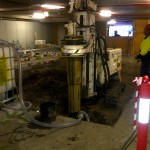Problems Solved by Access Piering:

Drilling in low headroom using polymer drilling fluid

Drilling for vertical pins anchors at Bellevue Hill
Wet Sand
- Wet sand, or saturated sand is very common ground condition in Sydney
- Care needs to be taken in drilling in wet sand as the water may be moving through the ground
- Our specialist CFA (or Grout Injected) drill rig and equipment can handle wet sand conditions.
Dry Sand
- Dry sand can also be a challenge for foundation construction
- Very dry sand with no fines or clay, sometimes called “Silica Sand”, is a commonly found in Sydney Eastern Suburbs.
- This material when picked up will run through your hand like water
- As you dig into the ground, the sand flows back into the hole
- CFA is the best technique for this type of ground
Rock
- Most foundations will bear on rock where possible
- Typical rock strengths around Sydney:
- 1000 kPa shale around Newtown
- 1500 to 6000 kPa sandstone in the Eastern Suburbs, some very hard rock in places.
- Our rigs can drill rock. We have drilled some very hard rock in Drummoyne, Rozelle, Bellevue Hill and Vaucluse
- We have a number of different options available in our factory to drill rock, depending on the hardness of the rock
Low Headroom
- As developers and property owners strive to add value to their properties, there may be a requirement to drill foundations under an existing building, so that additional structure can be added to the top of the building.
- We specialise in low headroom drilling
- We can drill a 6 m pier in headroom as low as 2.9 m
- We can drill a 14 m pier in 5.5 m headroom
- We have a range of techniques available to manage different ground conditions
High Water Table
- A high water table in the ground conditions will mean that the drilling will be into a ground that is fully saturated.
- As the drill enters and leaves the ground the sides of the hole will want to fill into the hole, pushed by the water on either side called “hole collapse” or “side wall collapse”.
- We have a number of techniques to manage a high water table. Call us today to discuss.
Difficult Access
- Difficult access can take many forms:
- Limited Access into site
- No access for the drill rig to site
- No access for concrete deliveries
- Reduced working space
- Have to crane the rig into the site
- Have to crane the soil out
- Restrictions can arise from a number and combination of constraints:
- Restricted hours of working
- Proximity to adjacent structures
- Proximity to railways
- Working inside existing structures
- We specialise in drilling on difficult sites
Difficult Ground
- All drilling into ground contains it challenges
- Even with the most thorough geotechnical report, the ground can still vary on one site.
- We have drilled into ground where rock and rubble from 150 years of continuous habitation on a site prevented any standard drilling techniques.
